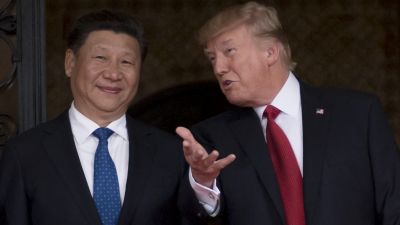
Ronald Reagan gives a televised address from the Oval Office, outlining his plan for Tax Reduction Legislation in July 1981. (Library of Congress via Wikimedia Commons)
This post originally appeared at OurFuture.org.
How do Democrats respond to the coming of Donald Trump? The tens of thousands in the streets across the country provide one answer: no business as usual. Trump’s first appointments — a retired general as national security advisor whom Colin Powell privately terms “right-wing nutty,” a senator as attorney general who was previously rejected for a judicial appointment because of his racist views and a former Goldman Sachs media mogul as “chief strategist” who peddles white supremacist and misogynist tripe – suggest the same. This will not be business as usual.
Democrats might learn something from the experience of an earlier Democratic Congress facing a shocking victory by an unlikely candidate. In 1980, Ronald Reagan was scorned as too inexperienced and reactionary for the presidency. Like Trump, Reagan ran a populist campaign laced with clear racial posturing. Like Trump, he was the outsider, defeating the establishment’s candidates, a Bush in the primaries, the sitting president in the general. Reagan peddled the voodoo that Trump echoed – massive top-end tax cuts, increases in the military budget and the promise to balance the budget. Like Trump, his victory was built on non-college-educated white, traditionally Democratic voters.
There are differences. Reagan won big, winning a majority of the popular vote and a stunning margin in the Electoral College (489-49). Trump lost the popular vote and drew the political equivalent of an inside straight to edge Clinton in the Electoral College. Reagan swept 12 senators into office with him giving Republicans the majority in the Senate, while Democrats retained the majority in the House. Trump’s victory helped Republicans keep the House and the Senate, despite losing seats in both. Reagan could claim a mandate that Trump lacks.
House Democrats under Speaker Tip O’Neill were appalled at Reagan’s program. O’Neill wanted to defend programs for the vulnerable that Reagan assaulted. But many Democrats – particularly those from Southern states that Reagan swept – thought it necessary to compromise. And Carter had already embraced much of the conservative agenda – deregulation, military buildup and vicious monetary policy. When Reagan was shot two months into his administration and “survived with a quip,” his popularity soared. Republicans unleashed a full-scale assault on O’Neill as out of touch at 68 years old.
O’Neill made concessions. In March, he agreed to expedited votes on the president’s economic program, worried that Democrats would look like obstructionists and lose still more seats in the midterm elections. In April, O’Neill threw in the towel, saying his experience had taught him “when you fight and when you don’t fight,” and it was time for retreat. Democrats, in the end, offered not an alternative drink, but a weaker tea. As The New York Times editorialized:
“For every tax break the White House offered the rich and powerful, the Democrats offered one of their own, sometimes two. They would give a marginal few dollars more to the less than well-to-do, but just as much to the rich. For the oil industry, the thrift banks, the nation’s charities, a few thousand commodity dealers and those looking to duck estate taxes, there is no anxiety about the final vote on these bills. Heads or tails, they win.”
Democrats, led by Ted Kennedy in the Senate, waged a rearguard action that helped restore some of what Reagan had slashed. After Reagan’s toxic brew contributed to a deep recession, Democrats won back 26 seats in the 1982 midterm elections. In the face of large deficits, Reagan signed off on measures that rolled back some of his tax cuts. After Democrats regained control of the Senate in 1986, O’Neill told the press: “The Reagan Revolution is over.”
He got that wrong. O’Neill and Democrats were focused on legislation and on congressional vote counts. Reagan was transforming our politics, launching a conservative era. He changed how Americans thought about government and the poor. He attacked labor and unleashed corporations. He weakened the capacity and the reputation of government. He accelerated deep transfers of wealth, fueling an inequality that distorts our economy and our politics. He deepened racial divisions to consolidate Nixon’s Southern strategy. By the time Reagan was done, Democrats like Bill Clinton were tacking to conservative winds.
Democrats might learn a clear lesson from this. They have little choice but to fight. If they accommodate Trump, they may lessen the damage he does. If his policy falters, they may regain seats in the mid-terms. Yet they can win battles and still lose the war.
This is a battle of direction as much as policy. Trump peddles a right-wing populism that pits working people against Washington elites who use government to coddle “those people” – people of color, immigrants, Muslims, women. He will push the full Reagan voodoo: deregulation and privatization, top end and corporate tax cuts, increases in military spending, while slashing basic services and capacities. Under the guise of deregulation, he’ll sabotage any leadership on climate change and gut research and investment in alternative energy and energy efficiency. That will drive out jobs, dry up investments and drain momentum on climate change.
Even Trump’s promise to rebuild America – his much touted infrastructure program that Democrats hope to join in supporting – is a bait-and-switch sting. Rather than public investment to build a modern, public infrastructure, it offers tax credits to businesses to encourage private takeover of infrastructure projects. Instead of the priority being the things we need – like a modern electric grid, or the repair of bridges, roads and schools – the priority will be things that investors can profit from: anything that can provide a steady stream of revenue from user fees, tolls or whatever. The likely result: a lower tax base for public provision, and scattered private projects that gouge taxpayers on the back-end. Think Chicago parking meters.
Democrats have to find a populist spine. Stand up clearly for poor and working people against the corporate lobbies and billionaire class that rig the economy against them. Expose the scams and corruptions. Show how efforts to drive us apart are central to the strategy of ripping us off. They can support Trump when he does something sensible – like deep-sixing the Trans-Pacific Partnership. But they have to be relentless in opposing his betrayal of the very people central to his election. This isn’t about Trump’s character, although he seems unable to play the role of president much less fulfill it. It’s about making it clear to Americans what side Trump and his administration are on. And that requires clear, constant and clarion contrasts.
For this to happen, progressives must take the lead – Sanders, Warren, Brown, Merkley and newcomer Harris in the Senate; the best of the Congressional Progressive Caucus with newcomers Raskin and Jayapal in the House. The senator from Wall Street won’t get it. The DNC needs to be lead by a populist champion like Keith Ellison, not by a former lobbyist or political retreads.
Trump has been elected despite losing the popular vote. He will take office. But there can be no business as usual.




